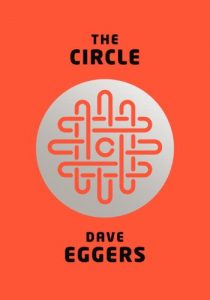The Handmaid’s Tale
by Margaret Atwood
Review By Dan Geddes
1 January 2001
Margaret Atwood’s The Handmaid’s Tale unabashedly places itself in the negative utopian tradition, and may actually herald the beginning of a new genre: the feminist negative utopia (dystopia).
Atwood’s novel depicts a not too futuristic society of Gilead, a society that overthrows the U.S. Government and institutes a totalitarian regime that seems to persecute women specifically. Apparently concerned by falling (Caucasian) birthrates, caused in part by a sterility virus, the Gilead regime reduces some women, the handmaids, to a purely procreational function. They are assigned to Commanders, who undergo a regular procreational ceremony with the handmaids, with the wife not only present, but lying directly under the handmaid to create the illusion that she is to be the impregnated vessel. This helps maintain the appearance of the sanctity of marriage, one of many Judeo-Christian dogmas that the Gilead regime fiercely upholds.
Although Atwood takes many shots at the beliefs of the Gilead regime, based as they are on a kind of neo-Old Testament view of women’s role in society, her critique is given through the eyes of one handmaid, Offred. Offred is in her early thirties, and like 1984‘s Winston Smith, can remember “the time before.” Her story is told in several narrative threads, which overlap by association. Thus, the “present tense” of her tale, concerns her assignment to a new Commander, one who eventually takes the liberty of inviting her to his study after hours (which is strictly forbidden), and furtively allowing her such luxuries as hand lotion, games of Scrabble, a little hectic reading (handmaids are forbidden reading and writing), and eventually a night out to a Commander’s club, where all the old vices are alive and well.
The other subplots concern her reminiscences on the “time before,” including memories of her boyfriend and daughter, her feminist mother, and her lesbian friend Moira, who underwent handmaid indoctrination with her at the Red Center. These subplots not only illuminate Offred, but also allow Atwood to describe the circumstances that preceded the “time before,” as well as the military takeover itself (important elements of negative utopian fiction). During the course of her assignment with the Commander, Offred gets away with many infractions, including a secret liaison with the chauffeur, and covert chats with another handmaid, who is a member of the underground. By the time the various narrative strands are completed we are given a fairly complete sketch of the social parameters of Gilead society.[1]
As negative utopian fiction, the goal of all this is too highlight the way in which the mores of contemporary society suggest ultimately repressive views when taken to their logical extremes. For Orwell, despite his prescient “predictions” about the authoritarian uses of technology, his major agenda was to call attention to the manipulation of political language and information to control thought. His work was an effective critique of Soviet propaganda (domestic and international) but applied to Western governments as well. Huxley’s Brave New World implied that continuous suggestion was an effective means of thought control; and he was more concerned than Orwell with the role of science, especially eugenics.
There are certainly elements of all this in The Handmaid’s Tale, but the main rhetorical thrusts are made against the repression of women, and of sexuality. The fact that the handmaids are assigned new patronymic names (Offred, Ofwarren) suggests how the Western practice of assigning women the man’s last name upon marriage defines women in terms of their men. That the handmaids are reduced to their procreational function parodies the way that some segments of society (the religious right perhaps) are said to view women. But there is a division of labor among women, so that those who are infertile because of age may become Marthas (the generic term for cooks), Aunts (the term for repressive matriarchs who indoctrinate the handmaids in their procreative function), Wives (who may or may not be infertile, but most of them seem to be the latter) and Econowives (for poor men). Worse is the fate of the Unwomen, a group that is never clearly defined, but seems to have either practiced abortion, became lesbians, or are shown to be infertile; to have somehow “failed” in their prescribed role. They are sent to the colonies (along with old women and Gender Traitors, i.e., homosexuals) to perform toxic cleanups, or perhaps less dangerous work. Female criminals of other sorts (the licentious) are publicly executed along with male criminals as examples. Handmaids are sometimes asked to take part in the executions, by beating the offenders and thus letting out some of their repressed urges.
As a feminist negative utopia, The Handmaid Tale has certain obvious villains, but it also underscores some of the inherent conflicts in contemporary feminism. The obvious villain is Western patriarchal society, which is commonly believed to be based on the Old Testament. Primary evidence against the Old Testament includes: Jehovah’s injunction to be “fruitful and multiply,” Eve’s commission of the Original Sin and her subsequent punishment of labor pains, and especially the Patriarch’s use of maids to produce heirs of the Blessing, when the wives appeared infertile. That the cultural influence of the Biblical depiction of women is the chief enemy[2] is seen in the trappings of the Gilead state: intolerant televangelists, selective and even erroneous Biblical quotations to justify Gileadean views, and the elite’s bearing of the name “Sons of Jacob,” among others.
It is important to keep in mind that the function of negative utopian literature is not to prophesy, but to warn, to spin out the implications of contemporary views and practices. It is perhaps justifiable to argue that if extreme elements of the religious right had their way then women would be denied certain legal liberties such as the right to abortion, and that such a regime would try to put the genie of permissive sexuality back in the bottle. Yet if Gileadean society is somehow a logical extension of our own, what would be the proper political stance for us, as defenders of a free society, to promote?
Feminism certainly contains a wide spectrum of gradations, especially as a movement that has received its primary theoretical impetus from the ideologically combative loins of the university. Certain views, such as the belief in the right to abortion and equality of opportunity, are held by a majority or near totality of women (in the case of the latter). But for issues that are controversial among feminists, like pornography and the institution of marriage, Atwood provides mouthpieces for diverging views, but does not seem to endorse one herself.
Perhaps it is rhetorically wise for Atwood to stick to the obvious and perhaps more dangerous targets on the radical right, rather than take a stand on the stickier issues. Her ideas are something that most non-radical right women can agree upon. But we leave The Handmaid’s Tale uncertain whether one of North America’s most popular women writers believes that pornography debases women (rather than expresses sexual liberation), whether marriage is inherently patriarchal or a proper step for a self-respecting woman to take (Atwood herself is married), or whether such practices as surrogate motherhood are ultimately sexist because they reduce women to their procreative function.
Whatever the vagaries in Atwood’s rhetorical stance, The Handmaid’s Tale does succeed as literature. Offred (a name which suggests that she will eventually discard the red dress of the handmaids, in addition to its patronymic suggestion), the narrator, is sensitively portrayed; it is impossible not to empathize with the victim of a totalitarian society. The various narrative threads are woven together nearly seamlessly, and the details provided by Atwood produce an adequate enough depiction of Gilead, though not comprehensive. Offred’s limited access to information precludes any such comprehensive description, which not only gives the reader some feeling for the mind controls of a totalitarian society, but serves as an effective narrative strategy; it withholds certain information, such as the description of the Gileadean takeover, (which is only given in the second half of the book) from readers, thus peaking their interest. The emphasis here (perhaps properly, given her ideological agenda) is on domestic life in the new regime, rather than the political structure or international status of Gilead society.
Atwood’s narration has a clear, almost mesmerizing quality to it. Offred describes her repressive atmosphere so vividly, that we are as a grateful as her to see chinks in Gilead’s armor. She is denied simple pleasures, so readers begin to appreciate the forbidden cigarette, the access to the outdoors, the right to read and write, speak freely, and all the rest. As readers we do begin to wonder, metatextually, how exactly, given the strictures against women writing, Offred’s document was composed, but we find the answer at the end. The last section, the “Historical Notes To The Handmaid’s Tale,” depicts the transcription of a future academic conference, from a time after the fall of the Gilead regime.
Here we discover that “The Handmaid’s Tale” was discovered as a set of thirty tape recordings, which explains the immediacy and orality of the narrative voice, as well as this particular arrangement of the various plot strands; the professors have put them together best they could, but are not sure of the intended order.[3] But the presenting professor is more concerned with the authenticity of the document, and in at least identifying Offred’s commander, and considers a few possibilities.
For Atwood the historical note serves several functions: it shows that Gileadean regime eventually falters; it allows her the opportunity to satirize academic objectivity; and it enables her to show the persistence of sexist views. For the professors, Gilead is considered, along with Iran, a late twentieth century theocracy, and so is treated without censure as a specimen for historical analysis. As the speaker says: our aim is “not to censure but to understand.” Yet Atwood clearly is censuring, and her barb is directed against current historiography, which shows a similarly rarefied objective tolerance for the historical subjugation of women, and even perhaps for contemporary Westerners who were “raised that way,” and so are often considered exempt from enlightening influences. That the futuristic professors themselves are not incapable of sexist jibes is seen by their referring to the Gileadean Underground Femaleroad, as the Underground Frailroad. There is, however, at least one female professor at this conference, so some of women’s equality of opportunity has been reclaimed.
As a reading experience, The Handmaid’s Tale, like most negative utopian literature, is more interesting as social critique than gripping as narrative. We read on to find out more about Gilead society (and Atwood’s perception of our own) than from fascination with plot or character. Offred is more of an anti-heroine than a protagonist, as her conflicts (against her society) can not really be won. Apparently, she is saved at the end by the underground, disguised as the Eyes (secret police), in a kind of deus ex machina ending. We are never to find out how she spends the rest of her days. There is no tragic element: unlike Winston Smith, she is not shattered or irreparably dehumanized by her experience. Indeed, over the course of the novel, Offred undergoes little character change, not even realization. We are concerned for her, but not gripped by how she will resolve her conflicts. She is our guide through Gileadean society, offering us a limited glimpse of a repressive regime, and our own conceptions of the role of women.
1 January 2001
Footnotes
[1] Gilead is a primarily a police-state, featuring numerous checkpoints, a dreaded secret police (The Eyes), and poor consumer products. Inevitably, it is at war, both internally (against groups such as Baptists and Quakers) and externally (the enemy, whoever they are, apparently have reached Florida). News is assumed to be pure propaganda. But since we always envision totalitarian governments as being total, we are always pleased and relieved to see the holes in the armor: the black market, the elite’s participation in forbidden activities, the occasional escape.
Despite the obvious limitations of Offred’s knowledge, I would have liked to hear more about the masses. We are primarily shown an elite household. We do not know how the Econofamilies live. We are not quite sure what has become of minorities (other than the Jews, many of whom go to Israel, some drowning along the way).
[2] That the Old Testament is believed to be the origin of much Western chauvinism is especially ironic in view of Harold Bloom’s The Book Of J, which argues that the original author of Genesis and Exodus was a Solomonic woman, whose original versions of the now Biblical tales depicted women in a sympathetic light, and did not imply and sanctify any of the repressive injunctions that are now cited to indict Christianity as patriarchal.
[3] In a lesser writer, I would argue that the idea of the future professors sticking the document together is a transparent device to absolve herself of any roughness in the narrative flow; the professors, not the author, would be accountable for any flaws in presentation. But since Atwood’s novel, in my opinion, does not suffer from this roughness, I wonder for what reason did she introduce this idea. To add credence to the role of the futuristic professors? To show the hurried and haphazard way the tapes had to be made? The point is not trivial, because negative utopian novels, as a special kind of historical fiction, have to explain their existence metatextually. Orwell simply hid behind traditional third person narrative omniscience. Since Atwood wanted a first person narrator, thereby adding vividness, she had to find the means to have Offred escape to make the tapes. If not, if Offred died, the reader would be left with the disappointing feeling that they had a document which could not have been written–given the internal logic of the fictional world.
But I have the sinking feeling that Atwood did not know how to finish her story; that she didn’t want her narrator harmed (for thematic as well as metatextual reasons) and so she left it unresolved. Some of this is cleared up by knowledge of her escape, but the fact that Offred, as narrator, would give us no (even coded) information about her present condition is in itself disappointing, and perhaps symptomatic of Atwood’s unwillingness to tell us more.
See also: Book reviews and criticism









[…] Geddes, D. 2001. Negative Utopia as Polemic: The Handmaid’s Tale. 1st January. The Satirist . [Online]. [10 November 2016]. Available from: http://www.thesatirist.com/books/HANDMAID.html […]
I’m glad you referenced my work.